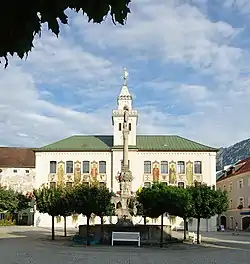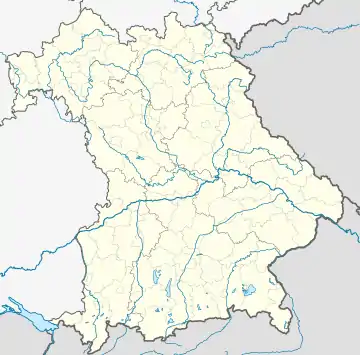Bad Reichenhall
Bad Reichenhall (Central Bavarian: Reichahoi) is a spa town, and administrative center of the Berchtesgadener Land district in Upper Bavaria, Germany. It is located near Salzburg in a basin encircled by the Chiemgau Alps (including Mount Staufen (1,771 m) and Mount Zwiesel (1,781 m)). Together with other alpine towns Bad Reichenhall engages in the Alpine Town of the Year Association for the implementation of the Alpine Convention to achieve sustainable development in the alpine arc. Bad Reichenhall was awarded Alpine Town of the Year in 2001.
Bad Reichenhall | |
|---|---|
 Town hall | |
 Coat of arms | |
Location of Bad Reichenhall within Berchtesgadener Land district  | |
 Bad Reichenhall  Bad Reichenhall | |
| Coordinates: 47°43′29″N 12°52′37″E | |
| Country | Germany |
| State | Bavaria |
| Admin. region | Upper Bavaria |
| District | Berchtesgadener Land |
| Government | |
| • Lord mayor (2020–26) | Christoph Lung[1] (CSU) |
| Area | |
| • Total | 39.44 km2 (15.23 sq mi) |
| Elevation | 473 m (1,552 ft) |
| Population (2022-12-31)[2] | |
| • Total | 18,893 |
| • Density | 480/km2 (1,200/sq mi) |
| Time zone | UTC+01:00 (CET) |
| • Summer (DST) | UTC+02:00 (CEST) |
| Postal codes | 83435 |
| Dialling codes | 08651 |
| Vehicle registration | BGL (until 1979: REI) |
| Website | www.stadt-bad-reichenhall.de |
Bad Reichenhall is a traditional center of salt production, obtained by evaporating water saturated with salt from brine ponds.
History
- The earliest known inhabitants of the area were tribes of the Glockenbecher-Culture (a Bronze Age Culture, from about 2000 B.C.)
- In the age of the La Tene culture (about 450 B.C.) organised salt production commenced utilising the local brine pools. In the same period a Celtic place of worship is placed at the "Langacker".
- From 15 B.C to 480 A.D, the city was part of a Roman province, Noricum.
- 1136 A.D bought the founding of a monastery St. Zeno.
- In 1617-1619, a wooden pipeline for brine exportation to Traunstein was built, with a length of 31 km, and more than 200 m in altitude difference.
- In 1834, two thirds of the city's buildings were destroyed by a major fire.
- The early 19th century saw the beginning of tourism, with Reichenhall becoming a famous health resort.
- From 1890 Reichenhall became known as "Bad Reichenhall".
- During World War II the area was bombed by Allied forces, killing 200 people on 25 April 1945. The town centre with many hospitals and the train station was nearly totally destroyed; the barracks did not suffer any damage. After the war the area was under American military governance (1945–1948).
- After World War II, the Americans established a Displaced Persons camp in the town, where Holocaust survivors lived for several years before immigrating to other countries.
- In 1947, Ben Gurion visited the DP camp, and saw the artworks created by Samuel Bak, one of the Holocaust survivors living at the camp.
- On 1 November 1999, 16-year-old Martin Peyerl shot at people in the streets from his bedroom window, killing three and wounding several others, among them actor Günter Lamprecht. He finally committed suicide after fatally shooting his sister and the family cat.
- In 2001 Bad Reichenhall was named Alpine Town of the Year and a few years later became a member of Alpine Pearls. [3]
Ice rink disaster
Fifteen people, twelve of them children, died in the collapse of the Bad Reichenhall Ice Rink on 2 January 2006. Thirty-four people were injured in the accident.[4]
Notable people from Bad Reichenhall
- Philipp Öttl (born 1996), World Super Bikes motorcycle racer for Team GoEleven[5]
- Anni Friesinger-Postma (born 1977), German speed skater (born in Bad Reichenhall, lived in Inzell ~10 km away and now lives in Salzburg)
- Lore Frisch, well known German actress in the 1940s and 1950s. Moved from Traunstein to Bad Reichenhall in the mid-1930s and got her start in acting in Bad Reichenhall before becoming famous in Munich and Berlin.
- Barbara Gruber, ski mountaineer
- Regina Häusl, alpine skier (born in Bad Reichenhall, started for the Ski-Klub Bad Reichenhall, lives in Schneizlreuth since her birth)
- Andreas Hinterstoisser (1914–1936), German mountaineer
- Andreas Hofer (composer), composer (1629–1684)
- Michael Neumayer, (* 1979), ski jumper
- Georg Nickaes, (* 1971), ski mountaineer
- Günther Rall (1918–2009), World War II Luftwaffe ace, postwar Luftwaffe general
- Karl Ullrich (1910–1996), SS Oberführer
- Johannes Frießner (1892–1971), World War II German Army general
- Walter Grabmann (1905–1992), German World War II Luftwaffe General
- Hans Söllner, (* 1955), singer-songwriter
- Peter Schreyer, (* 1953), car designer
- Franz Oberwinkler, (1939–2018), mycologist, expert on Heterobasidiomycetes
- Walter F. Tichy, (* 1952), computer scientist, initial developer of the RCS revision control system
- Hermann Gassner Jr (* 1988), rally driver
Gallery
 View from above
View from above Alte Saline (old saltworks)
Alte Saline (old saltworks) Karlstein castle ruins
Karlstein castle ruins St. George's church
St. George's church Powder tower
Powder tower St. Pancras church at night
St. Pancras church at night
References
- Liste der ersten Bürgermeister/Oberbürgermeister in kreisangehörigen Gemeinden, Bayerisches Landesamt für Statistik, accessed 19 July 2021.
- Genesis Online-Datenbank des Bayerischen Landesamtes für Statistik Tabelle 12411-003r Fortschreibung des Bevölkerungsstandes: Gemeinden, Stichtag (Einwohnerzahlen auf Grundlage des Zensus 2011)
- Website from alpine-pearls.com
- "Germany Roof Collapse". CBS News. 2006.
- "WorldSBK".
External links
- City of Bad Reichenhall (in German)
- Bad Reichenhall Tourist Centre (in German)
- Alpine Pearls
- History Salt Mine (in German)
- Museum (in German)
- AlpHaus Immobilien (in German)
- Library (in German)